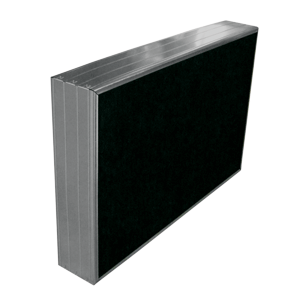1) You have performed comparative tests between standard acoustic splitters and external membrane splitters. Can you first enlighten us on their respective conceptions ?
The standard splitters consists of a simple plate of fibrous material of a certain thickness placed in the direction of the air flow. The two faces of the plate constitute acoustic absorbers which make it possible to attenuate the noise transmitted in the ventilation duct. The complete silencer consists of a set of parallel splitters and its efficiency depends on the thickness of the splitters and their spacing (airways). Generally, these devices make it possible to achieve very good attenuations in the medium and high frequencies bu are poorly suited to low frequency treatment.
The external membrane splitter is presented as a solution to compensate for this performance deficit in the low frequencies but it turns out that it is quite little verified in practice. Its design is based on the addition of a metal plate concealing half of each side of the splitter, these plates being placed in staggered rows. By design, this principle deprives the splitter of half of its absorbent surface, which is reflected in the performance measured in the medium and high frequencies. In the field of low frequencies, the performances are very dependent on the spacing between the splitters (ariways). It is only for very small spacings that the performances really become superior to the classic splitters. But this concerns implementation conditions that are very unfavorable from the aeraulic point of view since they are accompanied by high pressure losses.
2) What types of measures have been taken and on what type of equipment ?
The different test campaigns that we have been able to carry out on these two types of splitters have been conducted on a test bench complying with the recommendations of he ISO 7235 standard which is the reference in this field. In addition, for the very particular low frequency domain, we have also carried out additional measures to overcome the high uncertainties of the standardized method. These complementary methodologies have been published in particular in the journal “Acoustique et Techniques”.
3) What are your conclusions ?
Based on the comparative measurements we have made and the understanding we have of the acoustic principles involved, it is quite clear that external membrane splitters do not represent a truly effective solution for improving the attenuation of low frequencies. As they also lose some of their efficiency in medium and high frequencies, the balance is rather negative.
4) Is there a real solution to attenuate the low frequencies ?
Today, there is no specific solution to the problem of low frequencies. In practice, the only option is to use thick splitters installed in large silencers so as to preserve a passage of air sufficient from an aeraulic point of view.



